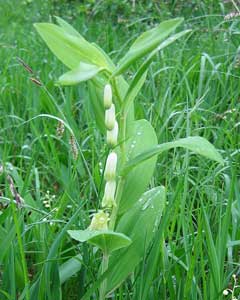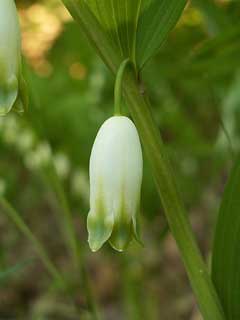 |
|
http://de.wikipedia.org/wiki/Benutzer:Hsuepfle |
 |
| http://de.wikipedia.org/wiki/Benutzer:Hsuepfle |
Translate this page:
Summary
Bloom Color: White. Main Bloom Time: Early spring, Mid spring. Form: Upright or erect.
Physical Characteristics

 Polygonatum odoratum is a PERENNIAL growing to 0.9 m (3ft) by 0.3 m (1ft in) at a medium rate.
Polygonatum odoratum is a PERENNIAL growing to 0.9 m (3ft) by 0.3 m (1ft in) at a medium rate.
See above for USDA hardiness. It is hardy to UK zone 4. It is in flower from May to July. The species is hermaphrodite (has both male and female organs) and is pollinated by Bees. The plant is self-fertile.
Suitable for: light (sandy), medium (loamy) and heavy (clay) soils and prefers well-drained soil. Suitable pH: mildly acid, neutral and basic (mildly alkaline) soils. It can grow in full shade (deep woodland) or semi-shade (light woodland). It prefers dry or moist soil.
UK Hardiness Map
US Hardiness Map
Synonyms
P. anceps. P. officinale. P. vulgaris.
Plant Habitats
Woodland Garden Dappled Shade; Shady Edge; not Deep Shade;
Edible Uses
Edible Parts: Leaves Root Shoots
Edible Uses:
Young shoots - cooked. They can be used as an asparagus substitute[46, 55, 61]. Root - cooked[2, 55, 105, 179]. Rich in starch.
References More on Edible Uses
Medicinal Uses
Plants For A Future can not take any responsibility for any adverse effects from the use of plants. Always seek advice from a professional before using a plant medicinally.
Antiperiodic Antitussive Cardiotonic Demulcent Diuretic Hypoglycaemic Miscellany Ophthalmic
Resolvent Sedative Tonic
Solomon's seal has been used for thousands of years in herbal medicine. It is used mainly in the form of a poultice and is believed to prevent excessive bruising and to stimulate tissue repair[254]. The root is antiperiodic, antitussive, cardiotonic, demulcent, diuretic, energizer, hypoglycaemic, ophthalmic, resolvent, sedative and tonic[7, 9, 21, 147, 174, 176, 178, 218]. It is used in the treatment of, dry throat, dry coughs and coronary heart disease[176]. The plant is only used in domestic medicine[9]. An infusion is used as a diuretic and stimulant to the metabolism, though no more than 3 cups per day should be taken and only over short periods[9]. It can also be applied externally as a poultice to treat bruises, small wounds etc[7, 9]. It has also been used to remove freckles[9, 21, 174, 176, 178]. The root is harvested in the autumn and can be dried for later use[9]. It should not be used internally except under expert supervision[254].
References More on Medicinal Uses
The Bookshop: Edible Plant Books
Our Latest books on Perennial Plants For Food Forests and Permaculture Gardens in paperback or digital formats.

Edible Tropical Plants
Food Forest Plants for Hotter Conditions: 250+ Plants For Tropical Food Forests & Permaculture Gardens.
More

Edible Temperate Plants
Plants for Your Food Forest: 500 Plants for Temperate Food Forests & Permaculture Gardens.
More

More Books
PFAF have eight books available in paperback and digital formats. Browse the shop for more information.
Shop Now
Other Uses
References More on Other Uses
Cultivation details
Landscape Uses:Container, Massing, Specimen, Woodland garden. Prefers a fertile humus rich moisture retentive well-drained soil in cool shade or semi-shade[200]. Plants are intolerant of heat and drought but tolerate most other conditions[200]. Prefers a dryish soil[10, 19]. Does well in woodlands and copses[1, 19]. Hardy to about -25°c[187]. The rhizomes are long and creeping, the plant forming large colonies[187]. The flowers are sweetly scented[245]. Members of this genus are rarely if ever troubled by browsing deer or rabbits[233]. The young shoots of most members of this genus are very attractive to slugs[K]. Hybridizes with other members of this genus[200]. A number of named forms have been selected for their ornamental value[187]. Special Features:Attractive foliage, Naturalizing, Suitable for cut flowers, Fragrant flowers.
References Carbon Farming Information and Carbon Sequestration Information
Temperature Converter
Type a value in the Celsius field to convert the value to Fahrenheit:
Fahrenheit:
The PFAF Bookshop
Plants For A Future have a number of books available in paperback and digital form. Book titles include Edible Plants, Edible Perennials, Edible Trees,Edible Shrubs, Woodland Gardening, and Temperate Food Forest Plants. Our new book is Food Forest Plants For Hotter Conditions (Tropical and Sub-Tropical).
Shop Now
Plant Propagation
Seed - best sown as soon as it is ripe in early autumn in a shady part of a cold greenhouse[200]. Sow stored seed as early in the year as possible. Germination can be slow, they may not come true to type[200] and it takes a few years for them to reach a good size. When they are large enough to handle, prick the seedlings out into individual pots and grow them on in a shady position in the greenhouse for at least their first winter. Plant them out into their permanent positions in late spring or early summer, after the last expected frosts. Division in March or October. Larger divisions can be planted out direct into their permanent positions. We have found that it is better to pot up the smaller divisions and grow them on in light shade in a cold frame until they are well established before planting them out in late spring or early summer.
Other Names
If available other names are mentioned here
Native Range
TEMPERATE ASIA: Mongolia, Russian Federation (Amur, Kurile Islands, Primorye (null), Sakhalin), China (Anhui Sheng, Gansu Sheng, Guangxi Zhuangzu Zizhiqu, Hebei Sheng, Heilongjiang Sheng, Henan Sheng, Hubei Sheng, Hunan Sheng, Jiangsu Sheng, Jiangxi Sheng, Liaoning Sheng, Nei Mongol Zizhiqu, Qinghai Sheng, Shaanxi Sheng (possibly), Shandong Sheng, Shanxi Sheng, Zhejiang Sheng (possibly)), Korea, Japan (Hokkaidô, Honshu, Kyushu, Shikoku), Taiwan EUROPE: Denmark, Finland, United Kingdom, Norway, Czechoslovakia, Austria, Belgium, Switzerland, Germany, Hungary, Netherlands, Poland, Russian Federation (Saratov, Volgogradskaja oblast), Former Yugoslavia, Albania, Bulgaria, Greece, Italy, Romania, Spain, France, Portugal
Weed Potential
Right plant wrong place. We are currently updating this section.
Please note that a plant may be invasive in one area but may not in your area so it's worth checking.
Conservation Status
IUCN Red List of Threatened Plants Status :

Growth: S = slow M = medium F = fast. Soil: L = light (sandy) M = medium H = heavy (clay). pH: A = acid N = neutral B = basic (alkaline). Shade: F = full shade S = semi-shade N = no shade. Moisture: D = dry M = Moist We = wet Wa = water.
Now available:
Food Forest Plants for Mediterranean Conditions
350+ Perennial Plants For Mediterranean and Drier Food Forests and Permaculture Gardens.
[Paperback and eBook]
This is the third in Plants For A Future's series of plant guides for food forests tailored to
specific climate zones. Following volumes on temperate and tropical ecosystems, this book focuses
on species suited to Mediterranean conditions—regions with hot, dry summers and cool, wet winters,
often facing the added challenge of climate change.
Read More
Expert comment
Author
(Mill.)Druce.
Botanical References
17200
Links / References
For a list of references used on this page please go here
Readers comment
© 2010, Plants For A Future. Plants For A Future is a charitable company limited by guarantee, registered in England and Wales. Charity No. 1057719, Company No. 3204567.